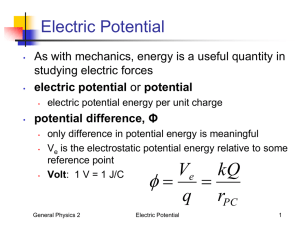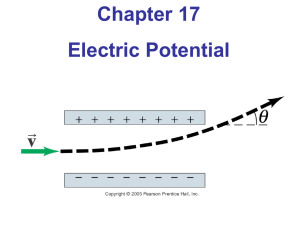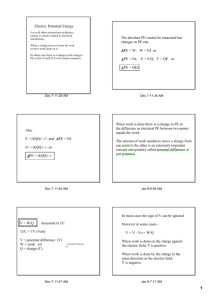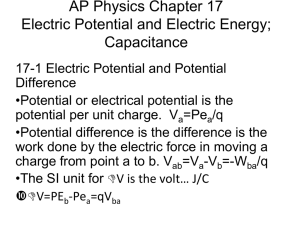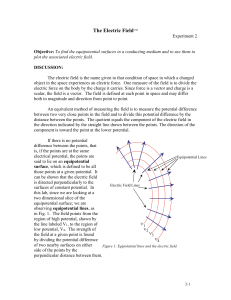SOTM LAB: P1
advertisement
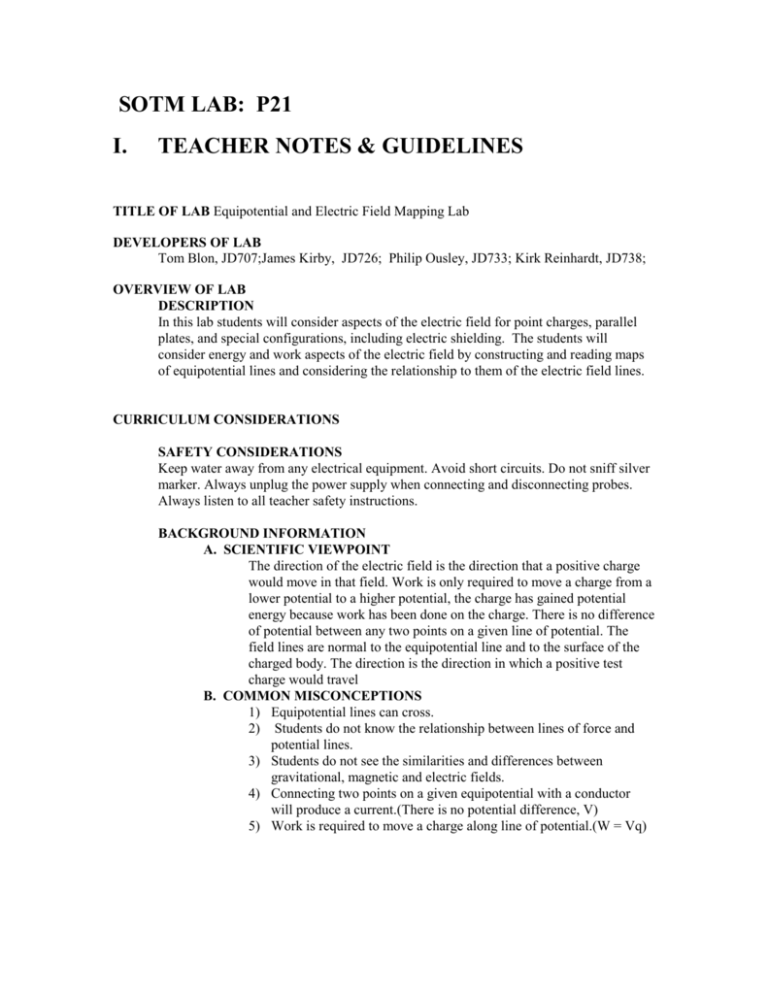
SOTM LAB: P21 I. TEACHER NOTES & GUIDELINES TITLE OF LAB Equipotential and Electric Field Mapping Lab DEVELOPERS OF LAB Tom Blon, JD707;James Kirby, JD726; Philip Ousley, JD733; Kirk Reinhardt, JD738; OVERVIEW OF LAB DESCRIPTION In this lab students will consider aspects of the electric field for point charges, parallel plates, and special configurations, including electric shielding. The students will consider energy and work aspects of the electric field by constructing and reading maps of equipotential lines and considering the relationship to them of the electric field lines. CURRICULUM CONSIDERATIONS SAFETY CONSIDERATIONS Keep water away from any electrical equipment. Avoid short circuits. Do not sniff silver marker. Always unplug the power supply when connecting and disconnecting probes. Always listen to all teacher safety instructions. BACKGROUND INFORMATION A. SCIENTIFIC VIEWPOINT The direction of the electric field is the direction that a positive charge would move in that field. Work is only required to move a charge from a lower potential to a higher potential, the charge has gained potential energy because work has been done on the charge. There is no difference of potential between any two points on a given line of potential. The field lines are normal to the equipotential line and to the surface of the charged body. The direction is the direction in which a positive test charge would travel B. COMMON MISCONCEPTIONS 1) Equipotential lines can cross. 2) Students do not know the relationship between lines of force and potential lines. 3) Students do not see the similarities and differences between gravitational, magnetic and electric fields. 4) Connecting two points on a given equipotential with a conductor will produce a current.(There is no potential difference, V) 5) Work is required to move a charge along line of potential.(W = Vq) OBJECTIVES 1. Students will be able to map equipotential and field lines. 2. Students will understand energy and work relationships regarding electric fields. 3. Students will be able to define equipotential lines and electric field lines and be able to explain the difference between them. EQUIPMENT/MATERIALS PROVIDED BY SOTM PASCO 750, laptop, and the Equipotential and field mapper kit (model # PK-9023). Instruction Manual should be included. A set of meter leads per mapper kit (see page 4 of manual). Prepared conductor sheets of parallel plates, point charges and matching paper grid sheets. Optional: Directions for set up and display of data in a 3 – Dimensional map of potentials. Both hard copy directions and disc with following programs attached: P21pts.xls & p21pll.xls (see attached graphs) ADVANCE PREPARATION Clean lab surface area for each lab group expected with electrical outlets for each group. Teacher should read instruction manual. Attached will be an Excel procedure for plotting the potential difference to create a 3dimensiuonal map of potential differences for the above listed models. If you choose this, the students will need to record the potential difference on the attached data sheet. II. PRE-LAB PRE-LAB EXERCISE TO ELICIT STUDENTS' PRIOR KNOWLEDGE AND MISCONCEPTIONS 1. Have students, in groups, come up with real life examples of doing work. Ask students what they believe doing electrical work means. 2. Ask students what they remember from earth science regarding contour mapping. Hand out contour maps or use demo chart. Review concept of different altitudes, contour interval and slope of land. 3. Ask students how they would design a contour map for gravitational potential energy levels of a 1kg mass about the earth. 4. What is the relationship between the work done on the mass as it travels along a constant potential energy level at a constant speed? 5. What path is taken by the mass as it increases in potential energy relative to gravitational lines of force? Decreases? 2 DISCUSSION OF PRECONCEPTIONS 1. Each group presents to class their ideas regarding real life examples of doing work. Other groups will be allowed to comment. 2. Each group presents to the class their contour map design for gravitational potential energy. Other groups are allowed to comment. 3. Teacher summarizes consensus for #1 and #2 and then asks students to answer #4 and #5 using that information. 4. Teacher tells students that lab activities will help them support or refute their ideas that they have developed here. III. EXPLORATION OF SCIENTIFIC PRINCIPLE & INTRODUCTION OF EXPERIMENTAL PROTOCOL PROBLEM Mapping equipotential lines of oppositely charged geometric shapes (point charges, parallel plates and special configuration). EXPERIMENT AND TECHNICAL OPERATION OF EQUIPMENT 1. Describe the apparatus including conductive paper, matching paper grids, probes, 750 interface (which includes the power supply) and laptop computer. 2. Demonstrate, using the parallel plate configuration, different potential “changes” as you make perpendicular movements of the positive probe and parallel movements of the positive probe. IV. ELABORATION OF SCIENTIFIC PRINCIPLE: INQUIRY-BASED STUDENT INVESTIGATION PROBLEM How can the researchers, by using the concept of potential differences, map equipotential lines in an electric field? Optional: How can the researcher, by using the concept of potential differences, map lines of force in an electric field? Potential gradient (E = V/t), compare parallel plates to two point charges. HYPOTHESIS OR PREDICTION 3 Discuss/sketch with your group members, what would a model of equipotential lines look like between oppositely charged parallel plates and oppositely charged points? Optional: Discuss/sketch with your group members, what would a model of lines of force look like between oppositely charged parallel plates and oppositely charged points? EXPERIMENTAL DESIGN 1. What are the variables that you will be measuring? 2. What measuring techniques will you use? 3. What tables and graphs will you need to create? 4. List safety precautions that must be observed. 5. Check with your instructor before actually setting up your experiment. (Suggested voltage is 5 V, which is the maximum output of the 750 interface) PLAN FOR DATA COLLECTION & ANALYSIS 1. What data are you going to collect? 2. How are you going to organize your data tables, graphs, etc.? 3. Check with your instructor before actually doing your experiment. CONDUCTING THE EXPERIMENT Students set up experiments and ask for guidance if necessary. Checkpoint (Teacher monitors students' investigations in progress.) ANALYSIS OF DATA Checkpoint (Teacher checks students' analysis.) DISCUSSION OF RESULTS . COMPARE: Lab groups compare their maps for the parallel plates, point charges, and the special configuration. PERSUADE: 1. Discuss your results with another group and try to reconcile any differences in the data. 2. Each group should draw conclusions based on the maps generated and explain them to a neighboring group. 3. Suggest any ideas for future experiments. RELATE Can you make a relationship between the electric potential lines of the fields to the gravitational potential lines in the pre-lab exercise? Can you predict the direction and relationship of the lines of electric force to the equipotential lines? 4 V. EVALUATION POST-LAB SURVEY OF STUDENTS' CONCEPTIONS Have students retake the pre-lab exercise. Compare pre-lab and post-lab responses. TRADITIONAL Select five to ten NYS Regents type questions. ALTERNATIVE Give the students a piece of graph with a varied electric field and have them draw the equipotential lines. (Time permitting, teacher could demonstrate on the mapper kit) 1) positive point charge & negative plate 2) two positive points charges 5 Appendix for using Excel spreadsheet: Plan “a”, no attached disc. A) Creating data table 1) On the second computer load excel. 2) Leave cell A1 empty. 3) Starting in A2 and ending in A16, enter numbers 0 through 28 by 2s. 4) Starting is B1and ending in L1, enter numbers 0 through 20 by 2s. 5) These will correspond to the needed cross hairs on the conductive paper for gathering potentials. 6) The students will enter in data to corresponding cells as another student reads the potential differences from the interface equipment from each point. B) Mapping data into a 3 – dimensional graph. 1) Highlight cells A1 through L16. 2) Click on the bar graph icon. 3) Choose chart type “surface” 4) Choose chart sub type “3-D surface” (top left). 5) Click next 6) Click next 7) Click next 8) Click potential 9) Right click on legend 10) Left click format legend 11) Click scale 12) Change major unit to 0.3 13) Click OK 14) Click and drag the graph to the right of the data. 15) You can rotate the 3-D image by clicking on one of the corners of the graph and rotating the mouse. C) Printing your map. 1) Click on File 2) Click page set up. 3) Choose landscape. 4) Click Print Plan “b”, disc attached. A) 1) 2) 3) B) 1) 2) 3) 4) Opening excel programs On the second computer load excel. Open “P21pts.xls or P21pll.xls” (pts is for points & pll is for parallel plates) The students will enter in data to corresponding cells as another student reads the potential differences from the interface equipment from each point. Printing your map. Click on File Click page set up. Choose landscape. Click Print This material is based upon work supported by the National Science Foundation under Grant No. ESI 9618936. Any opinions, findings, and conclusions or recommendations expressed in this material are those of the author(s) and do not necessarily reflect the views of the National Science Foundation. 6


